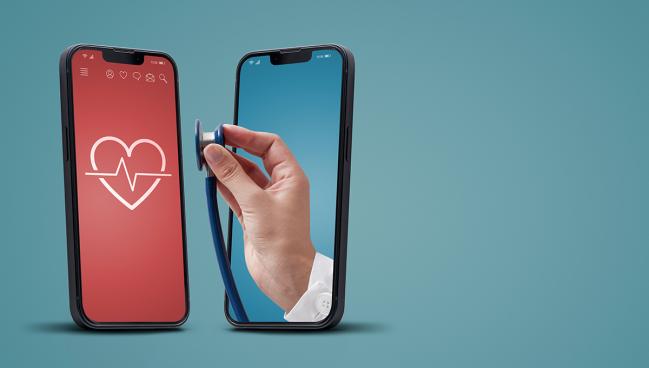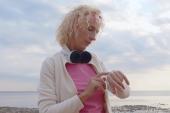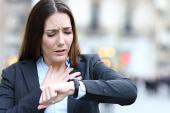Smartphone App Can Detect AF, Influence Care: eBRAVE-AF
Within 6 months of use, the screening tool more than doubled the odds that treatment-relevant AF would be diagnosed.

A smartphone-based screening tool can readily identify signs of atrial fibrillation (AF) that portend subsequent diagnosis and treatment, results from the eBRAVE-AF trial show.
eBRAVE-AF stands out as the first randomized trial in this space, which thus far has seen three large single-arm studies looking at wrist-based wearables. Use of the app, which researchers say works on 90% of currently available smartphones, more than doubled the odds that AF would be detected and oral anticoagulants prescribed in an elderly, at-risk population.
“This means that anyone with a smartphone can screen him or herself for the world’s most important cardiac arrhythmia. This might have huge implications for prevention of stroke,” investigator Axel Bauer, MD (Innsbruck Medical University, Austria), told journalists during a press conference. Bauer presented eBRAVE-AF in a Hot Line session Sunday at the European Society of Cardiology Congress 2022, and the findings were simultaneously published online in Nature Medicine.
“However,” he cautioned, “future studies are needed to inform us whether improved AF diagnostics through digital technologies indeed translate into better clinical outcomes.”
To TCTMD, Bauer described the obstacles to wider adoption of this app-based strategy in the real world. In doing eBRAVE-AF, one thing they learned “is that it’s very difficult to understand how to . . . motivate people to do these self-measurements. This is a screening approach that requires active willingness of participants,” he noted, adding that it also will be important to figure out which patients are most apt to benefit from screening and how best to implement these techniques on a wider scale, perhaps by cooperating with insurance companies.
And, as the researchers point out in their paper, there are many specifics to be worked out. Wearables offer the ease of continuous passive screening, while smartphones require users to periodically take active steps. Easy access to these devices is key, as well. “Ideally, digital technology is not limited to the product of a specific brand and runs on devices with a high penetration rate,” they write.
The eBRAVE-AF trial is unique in this way in that it recruited participants from the pool of policyholders of Versicherungskammer Bayern, a German health insurance company, and allowed them to use their own phones rather than steering them to a particular device. The previous Apple, Huawei, and Fitbit single-arm trials all involved brand-specific wrist-worn fitness trackers or watches. The prior studies also enrolled younger populations with lower stroke risk.
Diagnosis and Treatment, Too
In mid-2020, Bauer and colleagues invited 67,488 policyholders to participate in the study. Inclusion criteria included age 50-90 years, CHA2DS2-VASc ≥1 in men and ≥ 2 in women, being free of known AF, and not taking oral anticoagulants. Ultimately, they enrolled 5,551 of these individuals (median age 65 years; 31% female; median CHA2DS2-VASc of 3), randomizing them to digital screening via smartphone app or to usual care.
Participants in the digital screening arm used the Preventicus Heartbeats (Preventicus) app on their own smartphones to screen for irregular pulse waves by taking repetitive 1-minute photoplethysmogram (PPG) measurements. The median number of measurements per person was 53 (out of a scheduled 76). Abnormal PPG results were then confirmed using 14-day external ECG loop recorder.
For the primary endpoint, researchers chose newly diagnosed AF within 6 months that was, based on the diagnosis, treated with oral coagulation by a physician not involved in the trial. Digital screening more than doubled the likelihood that AF would be detected and treated compared with usual care (1.33% vs 0.63%; OR 2.12; 95% CI 1.19-3.76). In all, 3.1% of the 5,551 patients were lost to follow-up, 3.6% withdrew consent, and 0.16% died.
After the 6-month period, patients without a primary endpoint event were invited to cross over to the study’s opposite arm and 4,752 did so. Again, use of the screening app more than doubled the detection of treatment-worthy AF (1.38% vs 0.51%; OR 2.75; 95% CI 1.42-5.34).
The secondary endpoints of newly diagnosed AF (with or without anticoagulation) and prescription of oral anticoagulation each were increased with the app versus usual care in both phases of the study. An exploratory analysis looked at the 126 patients who developed MACCE over a median follow-up of 391 days. AF diagnosis, whether by app or usual care, significantly predicted MACCE risk (HR 6.13; 95% CI 3.07-12.21).
Abnormal PPG results were recorded by 173 digital-screening participants, with 61 AF diagnoses confirmed by external ECG loop recorder, amounting to a diagnostic yield of 35.2%.
Moving Beyond a Selected Population
Emma Svennberg, MD, PhD (Karolinska Institute, Stockholm, Sweden), the discussant for eBRAVE-AF in Sunday’s Hot Line session, agreed that the trial looks at a worthy question.
“Almost everyone has a smartphone these days, so indeed it is quite timely to do a trial using these devices to screen for atrial fibrillation,” she commented, adding that “not only did they look for atrial fibrillation using digital devices, they also onboarded patients using a digital strategy.” This is of particular interest, Svennberg told ESC attendees, given that the study was done in the thick of the COVID-19 pandemic.
She pointed out, though, that less than 10% of people invited to take part in eBRAVE-AF actually went on to do so and that the level of AF detection was lower than has been seen in some other screening trials. Finding out more about who participated and who did not could help clarify how generalizable the results are, said Svennberg. “We do know that nonparticipants in screening programs are generally less wealthy and less healthy, and more prone to having the disease, so this is an analysis that I’m looking forward to.”
Larger trials will be needed to assess whether the screening strategy impacts stroke rates, she added.
Still, though, in and of itself “this is a significant trial that brings the field of digital applications forward substantially,” agreed session chair Gerhard Hindricks (Heart Center of Leipzig, Germany). He asked Bauer how eBRAVE-AF maintained such active levels of engagement among those who enrolled.
Bauer emphasized, for context, that the trial was done remotely. “We had no face-to-face contact with any participants,” he said, unlike in STROKESTOP and LOOP, for instance, “where all these participants had conversations with their doctors. We had no chance to persuade the participants to take part. We only sent them letters, and these letters needing to be convincing.
“I think we were quite successful” by enrolling 8%, given the digital design, Bauer continued. “But you are completely right that we had a selected population. We had interested people . . . who like to take responsibility for their health, who like to deal with their health.” However, due to regulatory restraints, they won’t be able to know more about the people who declined to participate, he said.
If done on a larger scale, this screening would ask a lot from patients, Catherine M. Otto, MD (University of Washington School of Medicine, Seattle), pointed out in the discussion. “Having to go on your device and specifically take that time to record on a regular basis and do that every day, that’s going to be hard for people to do. Is this something that people could do once a year or every 6 months, or do we need to switch to the continuous smartwatch device approach? How could we really implement this across the population?”
Bauer said that regardless of whether the device requires patients to actively take measurements, screening generally must be an ongoing process. “I think AF detection should be treated like blood pressure control: [done] at regular intervals,” he said, adding, “It’s a continuous effort.”
Caitlin E. Cox is News Editor of TCTMD and Associate Director, Editorial Content at the Cardiovascular Research Foundation. She produces the…
Read Full BioSources
Rizas KD, Freyer L, Sappler N, et al. Smartphone-based screening for atrial fibrillation: a pragmatic randomized clinical trial. Nat Med. 2022;Epub ahead of print.
Disclosures
- Bauer reports a scientific grant from Pfizer.
- None of the authors has a financial, academic, or intellectual property conflict of interest with the mobile app company Preventicus.





Comments